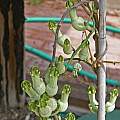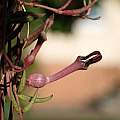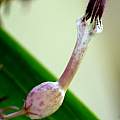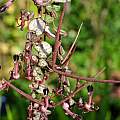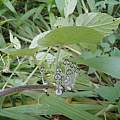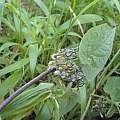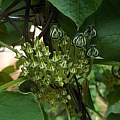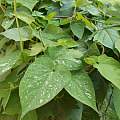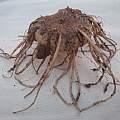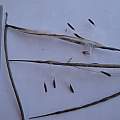Ceropegia is a genus of around 200 species found in Africa, India and Asia in the Asclepiadaceae subfamily of Apocynaceae. The name Ceropegia was coined by Linnaeus who thought the flowers looked like 'fountains of wax'. A feature of this genus is flowers that contain hairs which trap pollinating insects for a short time. Mostly species are succulent climbing plants, only some of which develop tuberous root-stocks. A popular house plant is Ceropegia linearis subsp. woodii known as 'String of Hearts'. Ceropegias are easily propagated by cuttings.
See Sage Reynolds' web site for a comprehensive survey.
Ceropegia ampliata with a tuberous root-stock is native to South Africa, common names include Taper Vine, Bushman's Pipe or Boesmanpypblom; 'ampliata' is a reference to its extra large (amplified) flowers. Like many succulent Ceropegias, the leaves are very small and short lived, while the stem is the main photosynthesis organ. Photograph by Andrew Wilson.
Ceropegia caffra (Schltr.) Bruyns see Brachystelma caffrum (Schltr.) N.E.Br.
Ceropegia cathcartensis (R.A.Dyer) Bruyns see Brachystelma cathcartense R.A.Dyer
Ceropegia linearis E.Mey. is the most commonly cultivated Ceropegia. Being more of a scrambler than a climber, the thin stems of this plant reach more than 2 meters length. It is an easy houseplant but also thrives in the garden during European summers, flowering prolifically when cultivated in hanging baskets. The tubers in this species seem to be optional - plants grown from seed always have it, those from cuttings may or may not produce one, and sometimes, a tuber is formed anywhere on the stem. Besides the tubers, the succulent leaves also help the plant to store water and deal with drought. The flowers tend to be paler and more patterned when receiving less light. Seeds are readily produced in long thin pods and germinate easily. Photos by Martin Bohnet.
Ceropegia linearis subsp. linearis is characterized by long, thin leaves with a silver line in the center.
Ceropegia linearis subsp. woodii, the common String-of-hearts, has wide leaves with various degrees of silver markings.
Ceropegia meyeriana (Schltr.) Bruyns see Brachystelma meyerianum Schltr.
Ceropegia papillata N.E.Brown is native to Tanzania, Malawi, DRC and Zambia growing in grasslands and open woodlands. Growth appears at the start of the rains with the flowers appearing in the axils of the leaves several months later. Easily grown in a well drained potting mix in full sun to light shade with ample water in the growing period and kept dry during dormancy. Photos by Nicholas Wightman of plants naturally occurring in Lilayi, Zambia.
Photos by Nicholas Wightman of leaves, tuber and seeds.
